Height optimization analysis of receiver tower of tower-type CSP plant
2022.07.27 From: POWERCHINA Northwest
Height optimization analysis of receiver tower of tower-type CSP plant
Authors: Siyuan Zhang, Zhi Zhou, Yajun Ren, Yingchun Wang
Receiver tower is the main structure in the heat-collecting system of tower-type solar thermal power plant and the tallest structure in solar thermal power plants. The main difficulty in the construction of receiver tower is to control the construction cost on the basis of ensuring the safe production and operation requirements of the power station (stiffness to meet the normal operation requirements of the equipment at the top of the tower, internal space to meet the requirements of traffic and equipment pipeline arrangement, etc.) and the aesthetic appearance of the landmark structure. In order to achieve efficient operation of the tower-type solar thermal power plant, the height of the receiver tower needs to be reasonably designed to achieve a balance between power plant efficiency and construction cost.
In this paper, a tower CSP plant with 700,000 m² solar field in a province of Northwest China is used as an example, and the performance evaluation software developed by POWERCHINA Northwest was applied to analyze the solar field efficiency and comprehensive benefits related to the height of the receiver tower. The aim is to propose the basic idea of the optimized height of the receiver tower, and to provide a reference for the optimal selection of the receiver tower height in the design of tower CSP plants.
1 Receiver tower height modeling analysis
1.1 The relationship between tower height and solar field efficiency
The height of the receiver tower is closely related to the solar field and local meteorological conditions. Given the same solar field area, the solar field efficiency will change as the height of the receiver tower increases. Solar field efficiency, as an important part of power plant efficiency, mainly involves cosine efficiency, shadowing and shading efficiency, atmospheric attenuation efficiency and truncation efficiency, wind speed related heliostats shutdown strategy, and receiver control strategy.
(1) Fixed tower height solar field efficiency analysis
The solar field efficiency is related to various factors such as tower height, solar field area, and local solar resources. In order to study the relationship between tower height and solar field efficiency, firstly, the height of the receiver tower is set to a fixed value of 200m, and the boundary conditions of the modeling side of the solar thermal power plant are input into the solar field layout software independently developed by POWERCHINA Northwest. The maximum density arrangement and the bionic arrangement combined with the patented technology of solar field arrangement to generate the corresponding solar field arrangement is shown in Figure 1
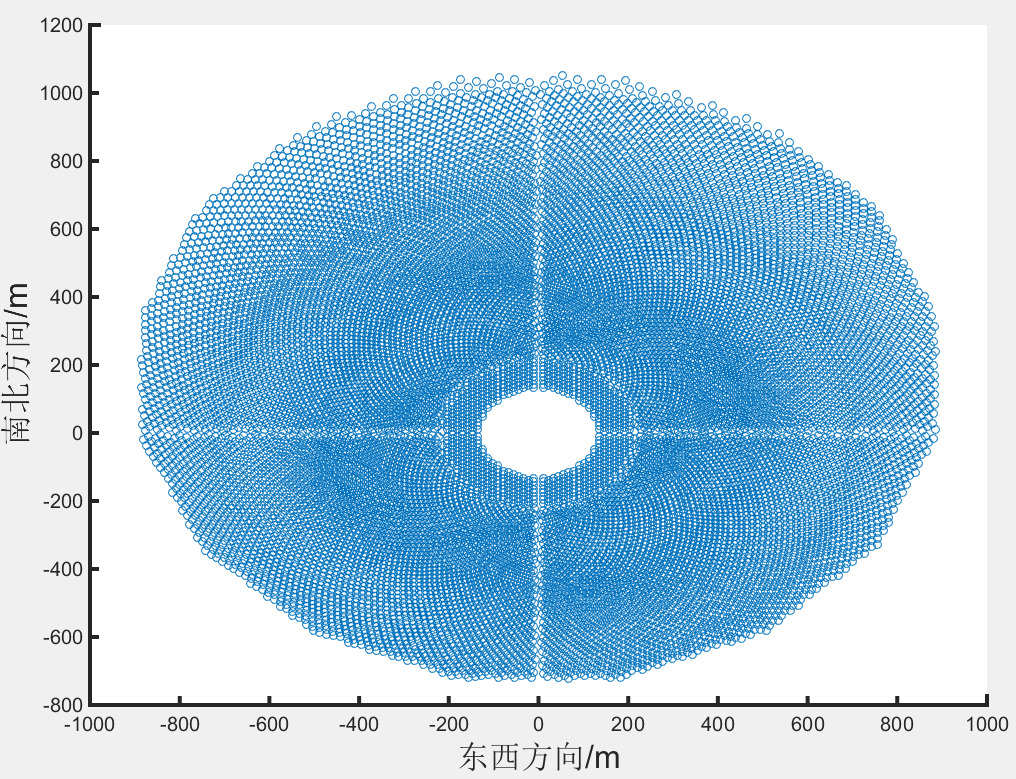
Figure 1 Solar field layout
According to the above solar field arrangement, the solar field cosine efficiency, shadow obscuration efficiency, atmospheric attenuation efficiency and truncation efficiency are analyzed separately using the self-developed solar field optical efficiency software.
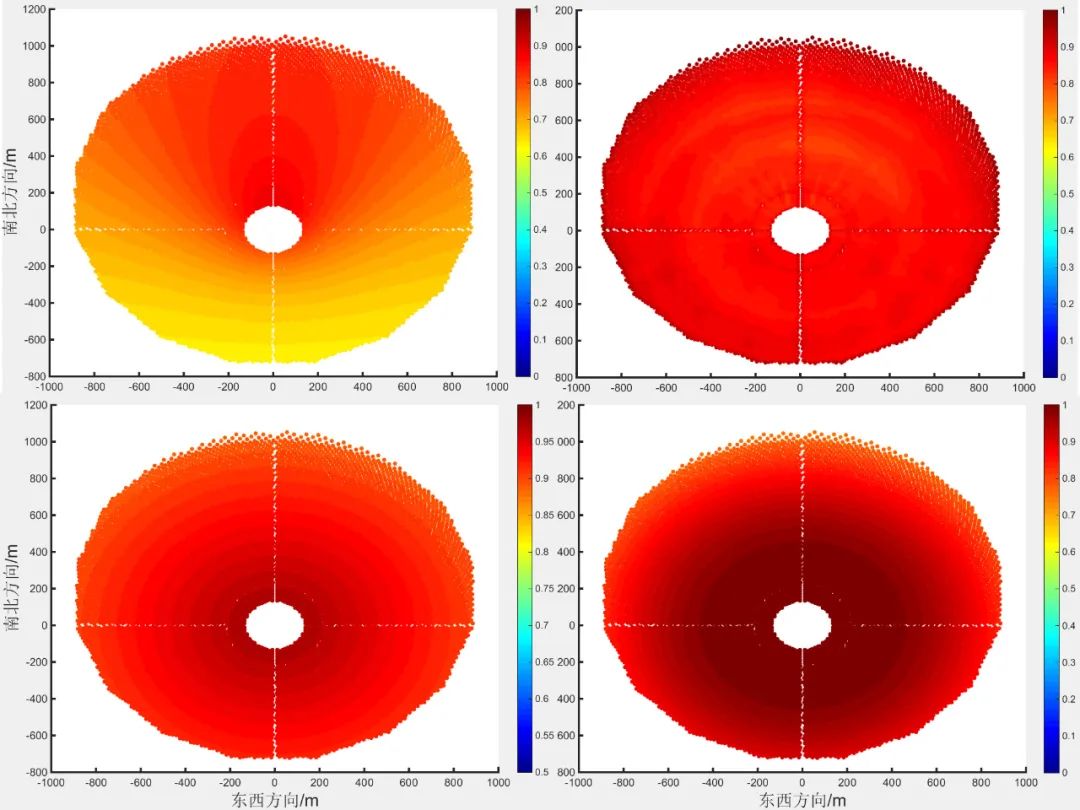
Figure 2-figure 5 shows the distribution of cosine efficiency, shading and blocking efficiency, atmospheric attenuation efficiency, and truncation efficiency of the solar field, respectively

Figure 6 Average annual efficiency distribution of solar fields
From the distribution of the solar field efficiency, it can be seen that the closer the area to the receiver tower, the higher the solar field efficiency. The variation of the tower height will affect the overall arrangement of the solar field, and thus the number of heliostats in the most efficient area of the solar field.
(2) Analysis of solar field efficiency at different tower heights
According to the boundary conditions of the project, seven tower heights with a receiver tower height from 150m to 210m, increasing every 10m, were analyzed. Using the self-developed solar field optimization software, the optimized solar fields for the corresponding tower heights were generated and their solar field efficiency was analyzed and studied, and the specific analysis results are shown in Figure 7.
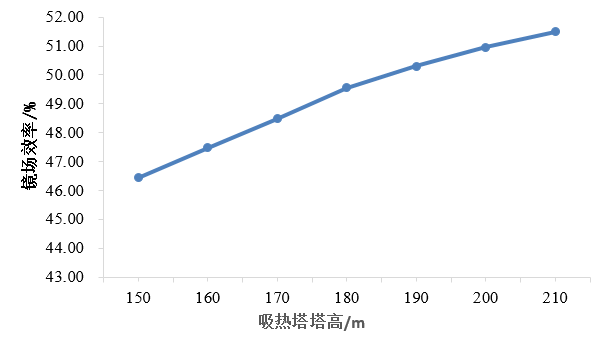
Figure 7 Relationship between tower height and solar field efficiency
As can be seen from Figure 7, based on the boundary conditions of the project, the solar field efficiency increases as the height of the receiver tower increases, and the increase tends to level off with increasing tower height.
1.2 The relationship between tower height and power generation
According to the above seven tower heights, the corresponding boundary conditions and technical parameters are input into the performance evaluation software shown in Figure 8 to form the corresponding tower CSP system configuration scheme, and the annual power generation of each scheme is simulated and measured.

Figure 8 Interface of the tower solar thermal system performance evaluation software
The calculated annual power generation for each configuration scenario is shown in Figure 9.
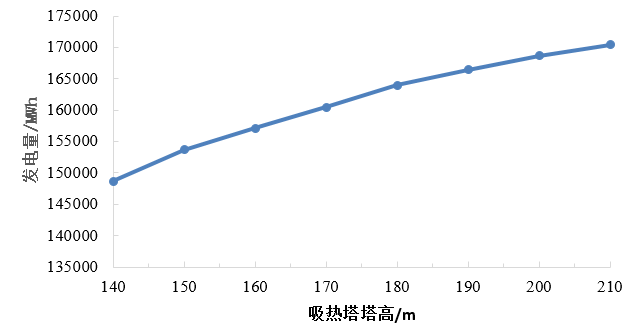
Figure 9 Relationship between tower height and power generation
From Figure 9, it can be obtained that the annual heat collection of the tower solar thermal power plant increases with the increase of the height of the receiver tower, which makes the annual power generation increase, but the increase flattens out gradually with the increase of the tower height.
2 Economic analysis of receiver tower construction
As the height of the receiver tower changes, the construction cost of the tower, the cost of the equipment inside the tower, the operating cost of the heat collection system and the income from power generation will also change, and the construction cost and corresponding income of the receiver tower are analyzed separately below.
2.1 Construction and operation cost analysis
(1) Construction cost analysis
The main construction cost of receiver tower mainly includes civil construction cost, heat tracing cost, piping cost and molten salt pump cost, etc., which are analyzed separately below.
It is measured that with the increase of tower height, the civil construction cost of receiver tower will increase, and the specific change trend is shown in Figure 10.

The relationship between receiver tower height and civil construction cost
At the same time, the increase of tower height will also make the receiver higher, which will make the corresponding increase of the cost of heat tracing, molten salt piping, molten salt pump and other equipment. Considering the above costs together, we can get the construction cost of receiver tower with different tower heights, as shown in Table 1.
Table 1 Construction cost with different tower heights
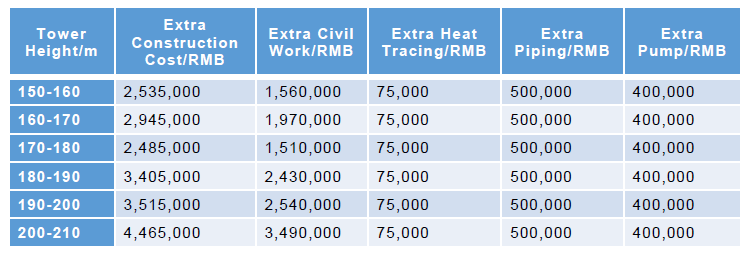
The analysis shows that with the increase of the height of the receiver tower, the civil construction cost is basically exponentially related to the tower height, while the cost of electric heat tracing, molten salt piping, molten salt pump cost is linearly related to the tower height.
(2) Operating cost analysis
The increase in operating costs caused by the increase in the height of the receiver tower is mainly the increase in electricity costs for the molten salt pump load. The electricity cost of molten salt pump is calculated at RMB 0.5/kWh, and the analysis shows that the increased operating cost due to the change of electricity consumption of molten salt pump during the 25-year operation period of the tower solar thermal power plant is RMB708,900/10m, which is linearly related to the height of the heat absorption tower.
2.2 Revenue Analysis
The revenue associated with the increased height of the receiver tower is mainly the revenue from the increased electricity generation capacity. The increased revenue from power generation during the 25-year operation period of the tower solar thermal power plant was converted to the first year after the plant was built, and the feed-in tariff was analyzed at three levels of RMB 0.3/kWh, RMB 0.6/kWh, and RMB 0.9/kWh, and the increased revenue from power generation at different tower heights is shown in Table 2.
Table 2 Generation revenue at different tower heights
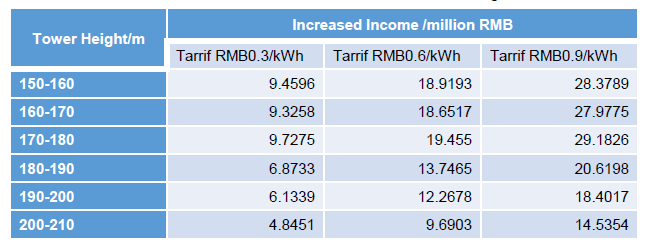
2.3 Receiver tower height selection
The changes in costs and revenues due to changes in tower height are summarized as shown in Table 3.
Table 3 Summary of cost revenue at different tower heights

The analysis shows that during the gradual increase of the height of the receiver tower, the revenue and cost both tend to increase for different feed-in tariffs, while the increase of revenue gradually slows down with the increase of the tower height. The increase in comprehensive revenue of the power plant under all three tariffs reached the maximum value when the height of the receiver tower was 180m, while the increase in comprehensive revenue gradually decreased after the tower height exceeded 180m. Therefore, when designing a tower-type solar thermal power plant, the height of the receiver tower should be reasonably determined according to the boundary conditions and specific requirements of the project.
In summary, as the height of the receiver tower increases, the difference between the benefit from the increased efficiency of the solar field and the cost paid for the increased height of the receiver tower becomes gradually smaller. Based on the boundary conditions of the project, the integrated return is highest when the height of the receiver tower is 180m, but the difference of the integrated return under different electricity prices is large. This method can be used to determine the height of the receiver tower in the process of designing a tower-type solar thermal power plant to improve the economics of the project.
More from CSP Focus
NextLeave your thoughts here
Reports(Member Only)
See more+-
CSP Focus Membership Proposals
We are now proposing CSP Focus Membership, hoping to better serve our members to keep pace with the latest updates of ongoing CSP projects worldwide, and to establish and maintain business relations with major shareholders of the projects. CSP Focus offers to Membership exclusive access to:1. Daily/Weekly update and analysis on CSP policies, projects, technologies, market trend and corporate relea
-
The Latest CSP Focus Monthly Update
Join CSP Focus Membership to Get the Latest CSP Focus Monthly Update December Edition.
-
CSP Project Monthly Update 2022 December Edition
CSP Focus is presenting CSP Project (China) Update 2022 December Edition.Detail report is available for CSP Focus Membership.
-
Presentations-CSP Focus China 2021
The Report is for CSP Focus Members only.
Upcoming Events
See more+-
12th CSP Focus China 2022
2022.04.21-22 Beijing
-
11th CSP Focus China 2021
2021.10.28-29 Beijing
-
10th CSP Focus China 2020
2020.10.22-23 Beijing, China
Project Updates
See more+-
Lanzhou Dacheng Dunhuang CSP Project
Asia Pacific-China,Operational,Parabolic Trough
-
Luneng Haixi 50MW Molten Salt Tower CSP Project
Asia Pacific-China,Operational,Power Tower
-
Dubai 950MW NOOR Energy 1 CSP+PV Project
MENA-UAE,Under construction,Power Tower
-
Power China Gonghe 50MW Molten Salt Tower CSP Project
Asia Pacific-China,Operational,Power Tower






